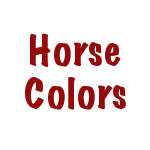 Slowly but surely I’m updating each section of the site. There is some great information on the site that isn’t so easy to find & navigate, so it’s winter cleaning time.
Slowly but surely I’m updating each section of the site. There is some great information on the site that isn’t so easy to find & navigate, so it’s winter cleaning time.
One Thing At A Time
Today I wanted to tell everyone about updates to the colors section. The colors were some of the first posts & wrote on the site and have slowly evolved into a section of their own. And rightly so, the genetics of horse colors is an incredibly involved and complicated business that is difficult to boil down into simple terms.
Layman’s Terms
Although it is complicated, I’ve tried to keep my information as simple as possible and to provide good images as references. I’m limited to what is in the public domain or licensed for reuse so anyone who has images they’d like to share I’d be happy to provide you credit for them.
Always Room for Improvement
At the end of the day genetics is a difficult field to nail down and I’ve done my best to represent the horse rainbow as simply and accurately as possible. Should any of my information conflict with current scientific knowledge, I hope someone will let me know…thanks. 🙂

I was reading the color page since I’m like obsessed with horse color, and I noticed that it said faded black generally do not produce bay foals, and I was like, why not? And then I remembered that the agouti black is has the extension genotype of E+ which they share with Bay, but the rare dominate black gene extension ED. Those horses can be jet black to a brown black or dark brown, and often are more brown because the gene is sort of leaky. Since Dominant black is dominant they very rarely produce bay foals, but it’s a different gene, then Agouti black, and it’s not faded black. I’m pretty sure faded black is only a form of agouti black.